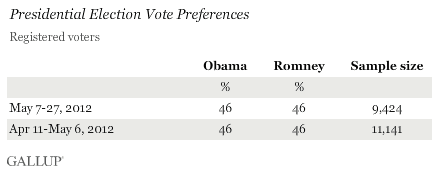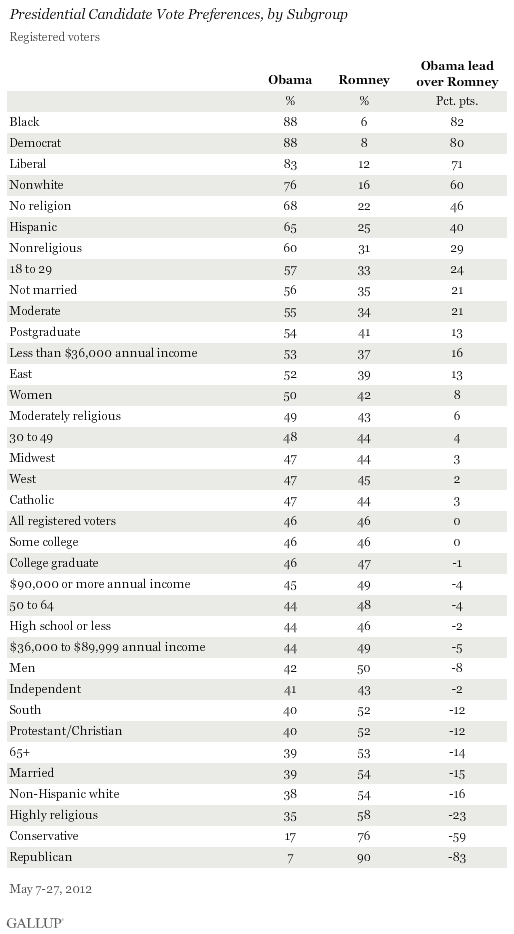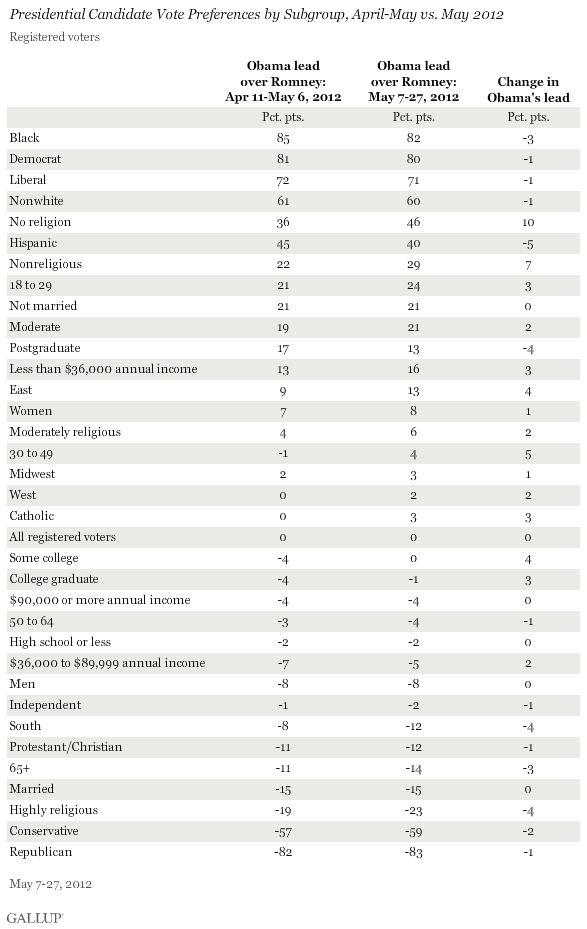PRINCETON, NJ -- Six weeks into Gallup's Daily tracking of the U.S. presidential election, the race remains highly stable, both overall and within demographic groups. Barack Obama and Mitt Romney are tied, 46% to 46%, among the more than 9,000 registered voters interviewed from May 7-27, exactly as they were in the previous three-week period.

Although the average vote choice between Obama and Romney has varied slightly in Gallup's seven-day rolling averages over the last six weeks, the larger three-week aggregates show no broad trends in one direction or the other.
Race, Politics, Religion Strongly Related to Vote Preferences
The May 7-27 aggregate shows that Obama continues to do particularly well among blacks, Hispanics, and nonwhites more generally, as well as among Democrats, liberals, and those who are not religious. Romney does particularly well among Republicans, conservatives, those who are highly religious, non-Catholic Christians, those who are married, older voters, and whites. Complete trends by subgroup for rolling three-week periods, including sample sizes for each subgroup, are available each week on Gallup.com.

Romney performs well among most subgroups of whites, as would be expected, given the strong relationship between race and vote preference. But Obama retains an edge among whites who are non-Christian or nonreligious, those who have never been married or are living with a domestic partner, and those with a postgraduate education.

Little Change in Support Among Subgroups
Subgroup preferences are little changed in the May 7-27 aggregate compared with April 11-May 6 interviewing -- reflecting the stability seen among all registered voters.

Although the Obama minus Romney "gap" has moved slightly over time in some instances, most of these movements are not substantively meaningful. Some news accounts have focused on possible changes and shifts in the vote preferences of women, but the comparison of these broad samples shows that women have not changed their vote intentions in any meaningful way.
One pattern, though, is worth noting: Voters who are less religious have shifted more toward Obama between these two periods, a trend that will need to be monitored in the weeks ahead.
Implications
To this point, all of the campaign events and rhetoric in the presidential election do not appear to have influenced voter preferences much. The two major-party candidates were tied last month, and remain tied today.
Both candidates will be working hard to change that situation in the three crucial summer months ahead, spending millions in advertising, participating in virtually nonstop campaign events and speeches, and pushing grass-roots efforts to mobilize voters.
There are no official campaign events until the Republican convention gets underway in Tampa on Aug. 27, followed by the Democratic convention in Charlotte in early September. Romney will be able to attract some attention with his vice presidential announcement -- and no doubt those on his campaign team will attempt to make that announcement when they believe it will have the maximum impact. Both candidates' campaigns will have to deal with the distraction of the July 27-Aug. 12 London Summer Olympics, when voters may pay less attention to political news.
The presidential campaign will also be affected by factors outside of either candidate's control, particularly the economy. Current trends on that front are at least slightly in Obama's favor, based on Gallup's ongoing measure of economic confidence, which shows that Americans are as positive now as they have been at any time since Daily tracking of that measure began in January 2008. Additionally, events in Europe and elsewhere around the world could affect the campaign, although new Gallup polling to be released Thursday suggests that the average American is not paying unusually close attention to the economic crisis in Europe at this point.
Survey Methods
Results are based on telephone interviews conducted as part of Gallup Daily tracking from April 11-May 27, 2012, with a random sample of 20,565 registered voters, aged 18 and older, living in all 50 U.S. states and the District of Columbia.
For results based on the 11,141 registered voters interviewed between April 11-May 6, and the 9,424 registered voters interviewed from May 7-May 27, one can say with 95% confidence that the maximum margin of sampling error is ±1 percentage point.
The maximum margin of sample error for subgroups of registered voters used in this analysis will vary depending on their sample sizes.
Interviews are conducted with respondents on landline telephones and cellular phones, with interviews conducted in Spanish for respondents who are primarily Spanish-speaking. Each sample includes a minimum quota of 400 cell phone respondents and 600 landline respondents per 1,000 national adults, with additional minimum quotas among landline respondents by region. Landline telephone numbers are chosen at random among listed telephone numbers. Cell phone numbers are selected using random-digit-dial methods. Landline respondents are chosen at random within each household on the basis of which member had the most recent birthday.
Samples are weighted by gender, age, race, Hispanic ethnicity, education, region, adults in the household, and phone status (cell phone only/landline only/both, cell phone mostly, and having an unlisted landline number). Demographic weighting targets are based on the March 2011 Current Population Survey figures for the aged 18 and older non-institutionalized population living in U.S. telephone households. All reported margins of sampling error include the computed design effects for weighting and sample design.
In addition to sampling error, question wording and practical difficulties in conducting surveys can introduce error or bias into the findings of public opinion polls.
For more details on Gallup's polling methodology, visit www.gallup.com.
